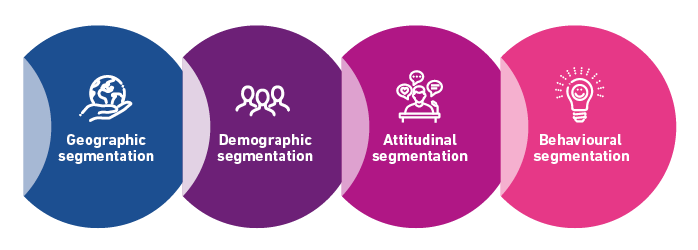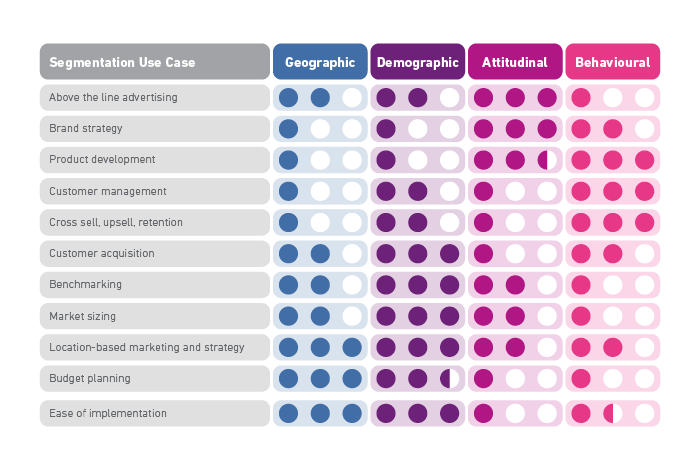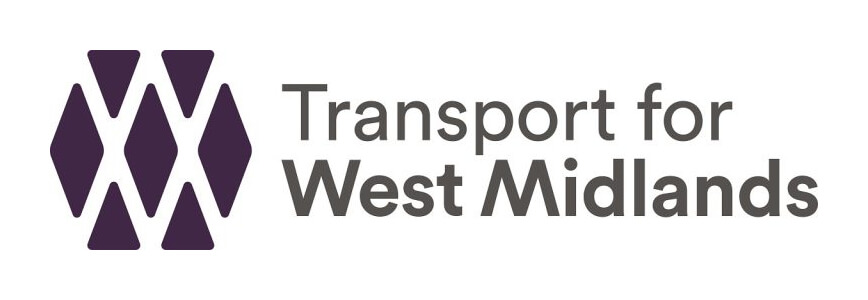What is market segmentation? The benefits and how to achieve success
Unlocking consumer insights that help your business thrive
Do you know who your best customers are, which offers and promotions they’re most likely to be interested in, and which channels they prefer? And do you know how to find and target new customers across the UK that share common traits with your existing customers?
Planning is critical – to make informed decisions about your marketing strategy and your product development roadmap you need to understand your target market, which of your existing customers are most engaged and how to offer increased value to your existing customers and potential new customers.
Read on to find out how you can group customers and prospects together based on shared attributes to boost your marketing strategy effectiveness, customer engagement and bottom line. Based on our experience of working with organisations on their segmentation projects, we share some of the essential constituents needed for successful customer and audience segmentation.
In this article we look at the benefits of market segmentation, the different types of market segmentation and how to make your segmentation project a success. But firstly, let’s look at what market segmentation is.
What is market segmentation?
Market segmentation is the process of dividing large sets of people, customers, households or areas into smaller groups, or 'segments', that have similar characteristics.
What is market segmentation?
Market segmentation is the process of dividing large sets of people, customers, households or areas into smaller groups, or ‘segments’, that have similar characteristics. When it comes to marketing, segmentation aims to match groups of people with common needs or likely interests in similar products and services.
The ability to do this means you can understand the needs of your customers more effectively and this, in turn, means you can target the specific customer segments who are most likely to engage with your brand, or purchase your products or services.
But it’s not just about understanding your existing customers. By combining insight on your customers with broader population insight, market segmentation provides a view of your overall addressable audience.
What are the different types of market segmentation?
Consumers can be segmented based on a wide range of criteria – from demographic segmentation and geographical (postcode) segmentation to psychographic segmentation, shared attitudes, income levels, lifestyles, buying behaviours and many more.
At a high level, the key segmentation types are: geographic segmentation, demographic segmentation, attitudinal segmentation and behavioural segmentation.

-
-
What is geographic segmentation?
Geographic segmentation is a market segmentation technique that divides a market into smaller groups based on geographic criteria, such as region, city, climate, or population density. This type of customer segmentation allows marketers to tailor their products, communication, and distribution strategies to the specific needs and preferences of customers in different geographic locations.
Geographic segmentation can support enhanced resource allocation by helping companies allocate their resources more effectively by focusing on the areas where they can achieve the greatest impact. By focusing marketing efforts on the most profitable geographic segments, companies can maximise their return on investment (ROI) and improve their overall financial performance.
-
What is demographic segmentation?
Demographic segmentation is the process of dividing a market into distinct groups based on shared characteristics such as age, gender, income, education, and family size. By using demographic information to understand their customers better, companies can create marketing campaigns that are specifically designed to reach and engage the desired demographic groups.
Demographic segmentation provides companies with a deeper understanding of their existing customers and prospects and the unique challenges they face. This deeper understanding can support marketing and product development by offering products and services that are relevant to the specific needs and preferences of different customer groups.
-
What is attitudinal segmentation?
Attitudinal segmentation is a technique that divides a market into groups based on consumers’ attitudes, beliefs, and opinions towards a product, brand, or service. This type of market segmentation is based on the principle that consumers with similar attitudes towards a product are more likely to exhibit similar purchasing behaviours.
Attitudinal segmentation (also known as psychographic segmentation) places an emphasis on characteristics such as personality and values. While two consumers may be very similar in terms of demographics, geographics and behaviour, their attitudes and motivations may be very different.
Needs-based segmentation is a similar technique which focuses on the principle that consumers with similar needs are more likely to have similar purchasing behaviours. Companies use needs-based segmentation to understand the motivations and drivers behind consumer purchasing decisions and to develop marketing strategies that meet the specific needs of different segments of their target audience.
-
What is behavioural segmentation?
Behavioural segmentation uses rich first-party information (i.e. information from your own internal systems) to show how your customers interact with your business and to help you engage with them more effectively. Typically, behavioural segmentation projects take into account a range of factors, including your customers’ purchasing and spending habits. This kind of customer segmentation considers how much, how often, and when customers make their purchases – and through which channels. In doing so, it allows you to gain a far greater understanding of customers’ wants and needs, and to target them with the right products, promotions and communications at the right time – via their preferred communications channel as part of an omnichannel communications strategy.
As well as supporting more effective, personalised marketing, and unlocking new cross- and up-selling opportunities, behavioural segmentation projects can help you to recognise long-time and repeat customers, and to reward them for their loyalty. You can also identify customers who are behind with their payments, or those who could benefit from changing to a different product or service based on their usage patterns – helping you fine-tune your customer relations, communications, and business strategies.
Transport for West Midlands (TfWM) were able to size, locate and understand the needs and interactions of citizens for future transportation and lifestyle needs. Combining data from YouGov, TfWM and Experian, our bespoke citizen segmentation offered TfWM a holistic view of their citizens’ demographics, attitudes towards travel and technology.
The segmentation has helped us ‘size’, ‘locate’ and ‘understand’ the interaction between transport and lifestyle and where consumer behaviour can be used to improve transport offerings, both for our products, and for the marketing and communications around our offers.
Sarah Bayliss, Human Intelligence Manager, Transport for West Midlands
What are the key benefits of market segmentation?
By grouping customers and prospects together based on shared attributes and needs, market segmentation delivers a number of key business benefits.
-
Increase in marketing effectiveness and return on investment (ROI)
Market segmentation gives you the ability to identify and target the high-value customers who are most likely to engage with you, or buy your products and services. Targeting ideal customer segments maximises ROI and reduces the costs associated with less effective ‘scatter-gun’ marketing approaches.
-
Optimal product planning and development
Market segmentation gives you a clear view of what customers love about your existing products and services – and how they would like to see your offers evolve and improve in the future.
-
Enhanced customer communications and engagement
Market segmentation provides insights into which communication channels your target customers prefer, and the kinds of offers and promotions they’re most interested in and likely to engage with.
-
Boost upselling and cross-selling revenues
Analysis of customer buying behaviour enables you to understand which customers are likely to be interested in other products and services in your portfolio.
-
Increase in customer loyalty and reduction in churn
Market segmentation helps you identify and reward customers who regularly engage with you or frequently buy your products and services.
-
Real-time segmentation can increase conversion
Being able to segment customers immediately during an online or telephone interaction enables marketers to offer promotional messaging that customers are likely to find of interest in order to boost conversion rates and revenues.
What do you need for successful market segmentation?
As we have seen, there are many ways to segment customers based on different criteria and different types of data. However, there are some common ingredients needed to deliver successful segmentation projects.
-
Clear objectives
It’s imperative to set clear objectives for segmentation projects at the outset, preferably with early input from an experienced consumer segmentation partner to ensure that all outputs of the project are fit for purpose.
This is because different market segmentation projects use different combinations of attitudinal, behavioural, geographic and demographic data. How much of each type of data is needed depends on the goals and objectives of each specific project. Each type of segmentation has specific strengths and weaknesses; there is no one size fits all.
For example, projects which are aimed at improving above-the-line advertising and brand loyalty typically rely on attitudinal segmentation and in particular, data related to customers’ opinions about your products, services, or communications. New product development and customer marketing projects, on the other hand, tend to rely more on behavioural data sources, such as the customers’ buying history or channel preferences.

-
A defined approach
There are different ways to approach a segmentation project; it’s important to understand the different approaches so that the most appropriate choice can be made for your project. The two key approaches are:
-
Bespoke/advanced segmentation projects
In this approach, the segmentation is custom-designed and tailored to the specific needs and goals of the company. Bespoke analytical techniques, data modelling and sophisticated statistical methods are used to identify and profile distinct market segments. In this type of project, a segmentation approach is developed which meets the unique needs of the company.
-
Pre-packaged segmentation projects
On the other hand, a pre-packaged segmentation project uses a pre-existing market segmentation solution that’s already developed and ready to use. This approach will often utilise standard data sources and segmentation methodologies.
The choice between opting for an advanced segmentation project and a pre-packaged segmentation project will depend on the specific goals and budget for the project.
-
-
Current, accurate consumer data
A growing range of attitudinal, behavioural, demographic and geographic data is available to help you understand your customers and prospects better. However, the ability to source and analyse the most relevant, accurate data is the key to creating actionable market segments.
Data should come from multiple, credible sources, and should be verifiable as accurate based on cross-referencing with customer and third-party data sources. Working with a trusted partner is critical to ensure data quality and accuracy.
-
Data modelling and analytics skills
Combining segmentation data to deliver specific insights requires data modelling and analysis. The ability to develop and run appropriate data models requires specialist skills and experience, as well as significant compute resources.
By bringing together these key ingredients, you can accelerate your customer segmentation projects and ensure that the insights generated by data models is relevant and able to deliver the required business outcomes.
Trusted by




We’re here to help make your segmentation a success
For every project, we work closely with you to understand your business objectives. We then conduct a thorough audit of available data – including your customer data and our UK consumer data – to ensure you get the marketing and business insights you need.
Working with your teams, our analysts create bespoke statistical models that shine new light on your customers’ wants and needs, and – if appropriate – give you far greater visibility of your existing market share and ‘headroom’ in specific customer segments and geographies across the UK.
There are a number of key reasons to work with us on your customer segmentation project.
- Our analytics team are experienced in developing segmentations that are actionable – supporting business planning, acquisition, customer management and location planning decisions.
- Using the combination of our data, client first-party data and attitudinal research data, we’re able to model market segments to wider customer and non-customer populations. This powerful data modelling enables clients to perform market size, headroom and geographical penetration analysis.
- We can support you with both advanced/bespoke segmentation projects and pre-packaged segmentation projects.
- Our Mosaic consumer classification platform contains rich UK consumer data, with pre-segmentation of customers into 15 key groups and 66 sub-segments. This can be further enriched with attitudinal and behavioural data as required to support specific marketing or product development use cases.
- If your segmentation requirements are global or multi-territory, then WorldView can help you to make impactful and informed decisions in international markets by accessing a set of consistent socio-demographic attributes.
- We have specialist tools for ‘scoring’ prospect models and for selecting individuals for targeted marketing across a range of channels. Our segmentations can be applied across a wide range of channels including direct mail, digital, out-of-home and connected TV.
- We have a tried and tested delivery model for bespoke segmentation projects, which begins with in-depth planning and objective setting to ensure that data and models are fit for purpose. Our segmentation project with Transport for West Midlands (TfWM) helped them to size, locate and understand the needs and interactions of citizens for future transportation and lifestyle needs. Utilising data from YouGov, TfWM and Experian, our bespoke segmentation provided TfWM with a holistic view of their citizens’ demographics, attitudes towards travel and technology.
-
How can we help?
We have the skills, experience and data resources to help you plan and execute your market segmentation project – whether you want to understand your existing customers better, or you wish to size the market for your products and services.
We’re here to help you to choose the right approach for your segmentation project.
Get in touch
We can help you to choose the right approach for your segmentation project.
Get in touch








